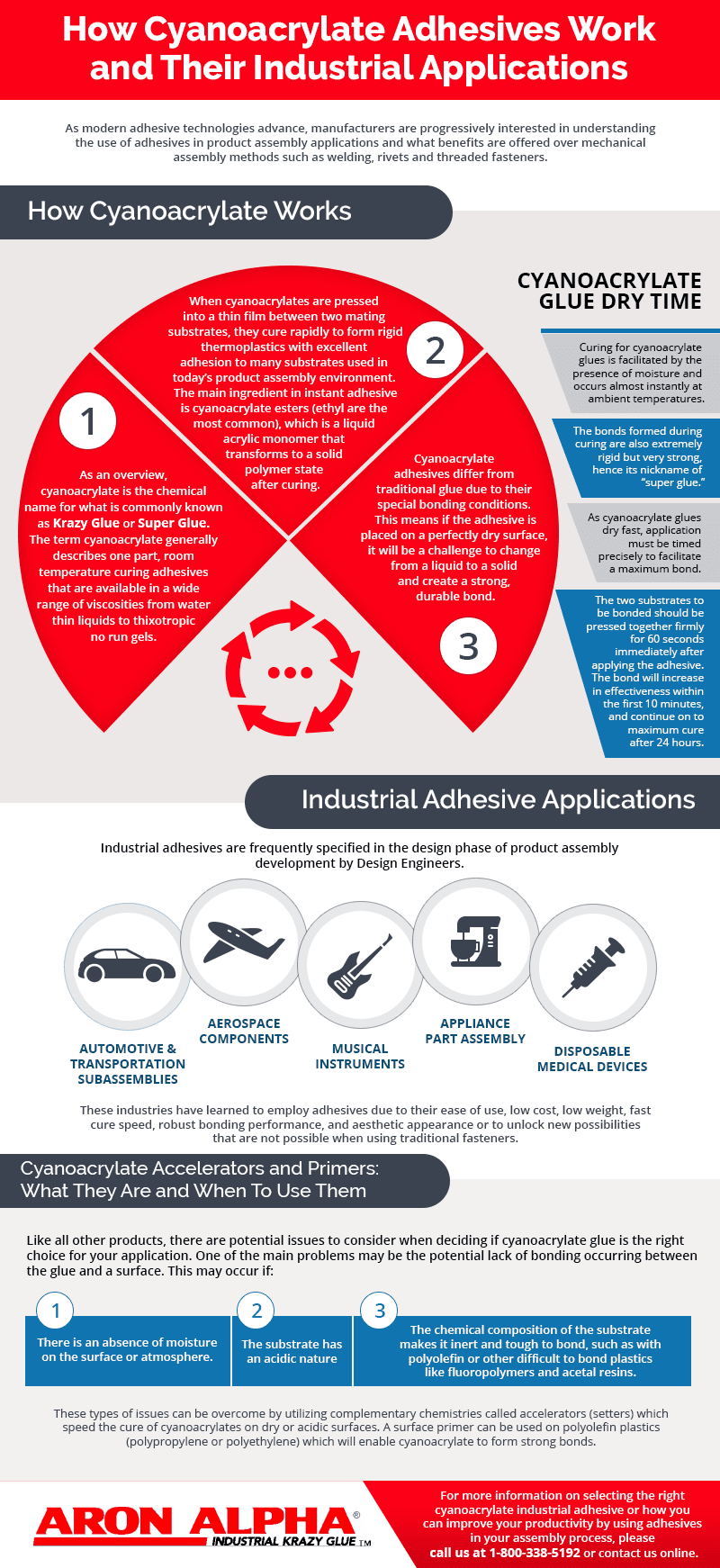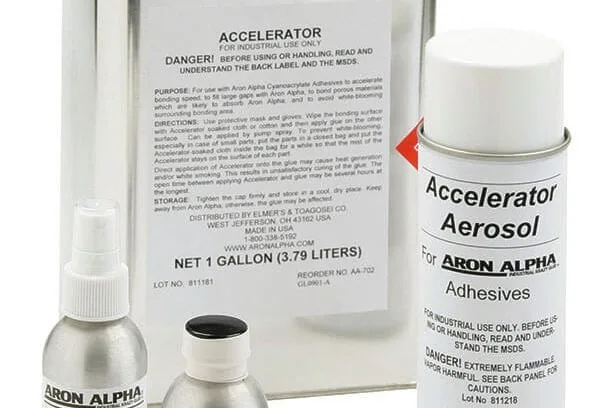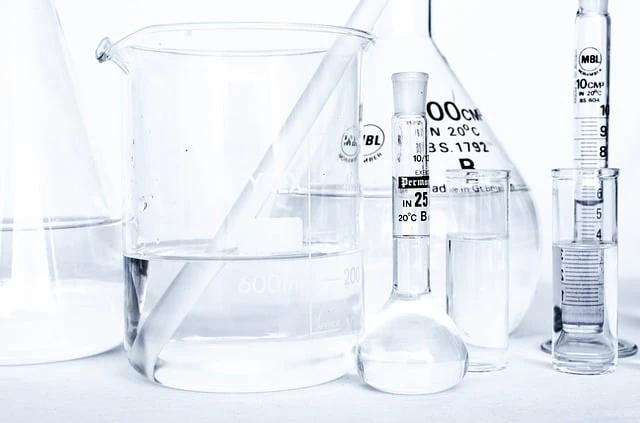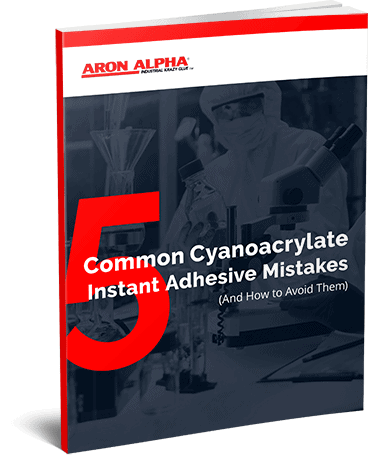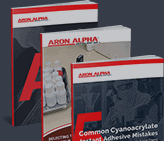How Cyanoacrylate Adhesives Work and Their Industrial Applications
As modern adhesive technologies advance, manufacturers are progressively interested in understanding the use of adhesives in product assembly applications and what benefits are offered over mechanical assembly methods such as welding, rivets and threaded fasteners. This post will help you gain a better understanding of how cyanoacrylates work and why they are a good choice as they relate to alternative fastening techniques.
Industrial Adhesive Applications
Industrial adhesives are frequently specified in the design phase of product assembly development by Design Engineers. Often Process Engineers and Quality Engineers will circle back to adhesives in order to correct or overcome a design flaw or process bottleneck during the fine tuning stage of product launch in the manufacturing environment. Adhesives are frequently used in bonding:
- Automotive subassemblies
- Aerospace components
- Musical instruments
- Appliance part assembly
- Disposable medical device applications
These industries have learned to employ adhesives due to their ease of use, low cost, low weight, fast cure speed, robust bonding performance, and aesthetic appearance or to unlock new possibilities that are not possible when using traditional fasteners.
How Ethyl Cyanoacrylate Works
As an overview, cyanoacrylate is the chemical name for what is commonly known as Krazy Glue or Super Glue. The term cyanoacrylate generally describes one part, room temperature curing adhesives that are available in a wide range of viscosities from water thin liquids to thixotropic no run gels.
When cyanoacrylates are pressed into a thin film between two mating substrates, they cure rapidly to form rigid thermoplastics with excellent adhesion to many substrates used in today’s product assembly environment. The main ingredient in instant adhesive is cyanoacrylate esters (ethyl are the most common), which is a liquid acrylic monomer that transforms to a solid polymer state after curing.
Cyanoacrylate adhesives differ from traditional glue due to their special bonding conditions. Whereas water- and solvent-based adhesives evaporate during the curing process or epoxy requires a two part system to initiate a cure, cyanoacrylate relies on atmospheric humidity and surface moisture as its catalyst. This means if the adhesive is placed on a perfectly dry surface, it will be a challenge to change from a liquid to a solid and create a strong, durable bond.
In contrast, when any amount of moisture is present, the molecules in the cyanoacrylate adhesive will react with the moisture to form long polymeric chains in between the two surfaces in contact. This reaction generates exothermic heat and occurs instantly, which differs from traditional glue bonding that occurs by evaporation of the base fluid. Curing is an important component for all adhesive types and should be considered when choosing the right type of adhesive for specific applications.
Cyanoacrylate Glue Dry Time
Broadly speaking, curing is defined as the process where a chemical reaction takes place to form harder and tougher linkages in a chemical substance. For some materials, this process will only occur at specific temperatures or humidity levels. For many non-cyanoacrylate glues, curing can be facilitated by radiation, heat, mixing, evaporation or UV light.
As mentioned above, curing for cyanoacrylate glues is facilitated by the presence of moisture and occurs almost instantly at ambient temperatures. The bonds formed during curing are also extremely rigid but very strong, hence its nickname of “super glue.”
As cyanoacrylate glues dry fast, application must be timed precisely to facilitate a maximum bond. The two substrates to be bonded should be pressed together firmly for 60 seconds immediately after applying the adhesive, and should not be repositioned or moved in any way during this period. The bond will increase in effectiveness within the first 10 minutes, and continue on to maximum cure after 24 hours.
On a related note, cyanoacrylate glues have a relatively short shelf-life and should only be purchased when need
ed for your assembly process—specifically, they have an average shelf life of one year from the date of manufacturing, and one month once the glue has been opened and exposed to your manufacturing environment. Do not purchase them in bulk or stockpile for future use.
Cyanoacrylate Accelerators: What They Are and When To Use Them
Like all other products, there are potential issues to consider when deciding if cyanoacrylate glue is the right choice for your application. One of the main problems may be the potential lack of bonding occurring between the glue and a surface. This may occur if:
- There is an absence of moisture on the surface or atmosphere
- The substrate has an acidic nature
- The chemical composition of the substrate makes it inert and tough to bond, such as with polyolefin or other difficult to bond plastics like fluoropolymers and acetal resins
These types of issues can be overcome by utilizing complementary chemistries called accelerators (sett
ers) which speed the cure of cyanoacrylates on dry or acidic surfaces. A surface primer can be used on polyolefin plastics (polypropylene or polyethylene) which will enable cyanoacrylate to form strong bonds.
How to Remove Cyanoacrylate and Other Super Glues
Another common issue with using cyanoacrylate is its tendency to form strong bonds with undesirable surfaces, such as the operator’s skin or clothing. To correct these undesirable bonding issues, it is necessary to apply a cyanoacrylate solvent. Here is a breakdown of the various surfaces where undesirable bonds might take place and how to remove cyanoacrylate:
Skin or Fabric
Human skin is constantly perspiring and generates a natural layer of moisture, enhancing the conditions forrapidcyanoacrylate curing. A simple remedy for removing cyanoacrylatefrom skin is to apply acetone or nail polish remover to the affected area (skin or fabric). However, beware of using acetone on the lips, eyes, or other areas of high sensitivity as the acetone might cause further damage. In these instances, margarine, peanut butter, or vegetable oil can help break the bond. If these remedies are unsuccessful, consult a health care professional.
Glass
There are two common undesirable glass surfaces where cyanoacrylate sometimes creates its stubborn adhesive bond, including:
- Eyeglasses are particularly sensitive when it comes to adhesive removal because scratching or scraping the surface ruins the lenses. Among the cyanoacrylate solvents used to remove the adhesive from eyeglasses are hot water, alcohol, acetone, and toothpaste. This method also works best for glass screens on computer monitors, televisions, and smartphones.
- Other Glass Surfaces. For less fragile and scratch-resistant glass surfaces, a razor blade can also be applied in conjunction with solvents to scrape away the residue.
Metal
Metal surfaces are often victims of spilled or dropped cyanoacrylate, creating an instant bond under ideal conditions. Removal of the adhesive using a cyanoacrylate solvent such as acetone, a paint scraper, and a hammer will quickly resolve the issue. Here are the necessary steps:
- Moisten the affected area with acetone to soften the adhesive
- Use the paint scraper to scrape the glue from the surface
- For large spills, lightly tapping on a drop of cyanoacrylate adhesive with a hammer will break up the bond on flat surfaces and allow for easier removal
Plastic or Vinyl
Unlike metal and glass, removing cyanoacrylate adhesive from plastic or vinyl can be a much more challenging prospect. Marring or blemishing the surface of plastic is a common problem when attempting to remove errant super glue drops or spills. The problem is multiplied if the surface includes paint or veneer in its finish. Here are some solutions:
- Soak the item in non-ammonia detergent and water. This can help soften the bond for removal without doing damage to the surface of the item.
- Acetone is a more aggressive solution as a cyanoacrylate solvent. It will do the job, but it has the potential of causing damage to certain types of plastic or vinyl.
- Nitromethane is a milder alternative to acetone, which is less likely to do damage to the applied surface.
Cyanoacrylate Solvents
Softening and un-bonding cyanoacrylate once it has been applied to undesirable surfaces is the most effective way of removing the adhesive without having to revert to harsher mechanical solutions. Here is a quick list of cyanoacrylate solvents that help to loosen the bond and allow for removal:
- Water
- Acetone
- Vegetable oil
- Peanut butter
- Nitromethane
- Dimethyl sulfoxide
- Methylene chloride
- Gamma-Butyrolactone
Cyanoacrylate Toxicity
A safety consideration to keep in mind with all adhesives relates to their toxicity. Cyanoacrylate poisoning can occur in varying degrees depending upon the formulation of the adhesive and the level of exposure. The most common form of toxicity issues relate to respiratory sensitivity, but it can also affect the skin and eyes. Toxicity may occur from ingestion once the adhesive has solidified, but it is nearly impossible to ingest in its liquid or gel state because it dries so quickly in a moisture rich environment.
Symptoms of cyanoacrylate poisoning typically include:
- Skin or hair bonding
- Skin irritation (burning, rash)
- Flu-like symptoms due to inhalation (can lead to asthma or aggravate asthmatic conditions)
If poisoning is due to inhalation, the remedy is to provide improved ventilation in areas where the adhesive is used and ensure use of the proper respiratory equipment to prevent sensitivity to the substance from developing. In the case of ingestion, encourage vomiting as the stomach’s acid will help loosen the bond and expel it from the mouth and esophagus.
Cyanoacrylates are minimally toxic, so severe damage or impairment is rare. As an example of its toxicity levels, a common use of cyanoacrylate adhesives relates to wound closing applications in medical treatment.
The Advantages and Disadvantages of Cyanoacrylate
Cyanoacrylates come with a range of advantages and disadvantages that make them an ideal solution for some applications while they should be avoided in others.
Advantages include:
- One-part adhesive system
- Solvent-free
- Rapid room temperature curing
- Excellent adhesion to many substrates
- Easy to dispense in automated systems
- Wide range of viscosities
- Excellent shear and tensile strength
Disadvantages include:
- Poor peel strength
- Limited gap cure
- Poor solvent resistance
- Low temperature resistance (up to 250° F)
- Bonds skin instantly
Cyanoacrylate Industrial Adhesive from Aron Alpha
Aron Alpha provides a wide range of industrial cyanoacrylate instant adhesives, primers, accelerators, and applicators for a variety of industrial applications. For more information on selecting the right cyanoacrylate industrial adhesive or how you can improve your productivity by using adhesives in your assembly process, please call us at 1-800-338-5192 or contact us online.
Download Our eBook
There are several commonly-made mistakes that can render the use of cyanoacrylate adhesives ineffective or inefficient, and it is important to know how to smoothly steer clear of them. This guide walks through 5 of the most common cyanoacrylate adhesive mistakes so that you may avoid them during your projects.
Learn More

